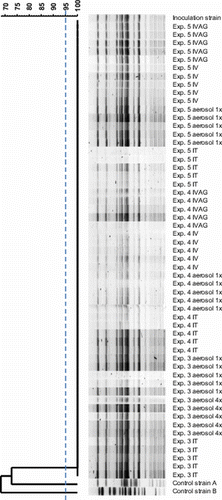Figures & data
Table 1. E. coli peritonitis syndrome in egg-producing brown layers after E. coli administration by different routes
Figure 1. Restriction endonuclease digestion patterns obtained by PFGE of re-isolated E. coli from Experiments 3, 4 and 5 (n=5 re-isolates per experimental group; two re-isolates of orally inoculated birds of Experiment 4 were not tested) were considered genetically indistinguishable compared the inoculum strain. The two control isolates A and B originating from two different field outbreaks of EPS appeared to be genetically unrelated to the former isolates. IVAG, i.v., aerosol 1×, i.t. and aerosol 4× denote the inoculation or exposure routes by order of appearance in the figure, which are intravaginal, intravenous, aerosol once, intratracheal and aerosol four times, respectively. The dendrogram was constructed based on Dice similarity comparison of fragment profiles followed by UPGMA analysis.
